Summary
- Google Data Analytics (Coursera) – Beginner-accessible route through SQL, R, and Tableau, producing portfolio projects worth showing.
- Learn SQL (Codecademy) – An Interactive platform where SQL queries get written and tested immediately, hands-on from minute one.
- Data Analysis with Python (freeCodeCamp) – Totally free, project-rich program exploring Pandas, NumPy, and visualization deeply.
- Power BI for Beginners (Great Learning) – First interactive dashboards and reports completed inside three hours – rapid skill building.
- R Programming (Johns Hopkins University on Coursera) – In-depth R programming and statistical computing from established professors.
If you’ve ever wondered why “data analyst” appears in every other job posting lately, here’s the short answer: companies are collecting information at a ridiculous pace, and most of them struggle to keep up. The backlog grows. Fresh information becomes stale information, still sitting there, still holding answers, but aging out of relevance while everyone’s too busy collecting more.
Data analysts interrupt that cycle, digging through accumulating records and surfacing insights before the moment to act on them passes entirely. You can jump into this world where real skills mean more than diplomas without spending a dime. The best free data analytics courses teach the essentials – SQL, Python, BI tools – minus the tuition fees.
This article walks you through the best free options for 2026 – courses that build actual skills instead of just dropping a PDF certification into your email box and wishing you luck.
Table of Contents
- Why Data Analytics is a Great Career Choice
- Top 5 Free Data Analytics Courses for Beginners
- Best Free Courses to Master Specific Data Analytics Tools
- Top University-Led Free Data Analytics Courses
- The Missing Piece: Why Data Integration is a Crucial Skill for Data Analysts
- Comparison Table
- How to Choose the Right Free Data Analytics Course for You
- Conclusion
Why Data Analytics is a Great Career Choice
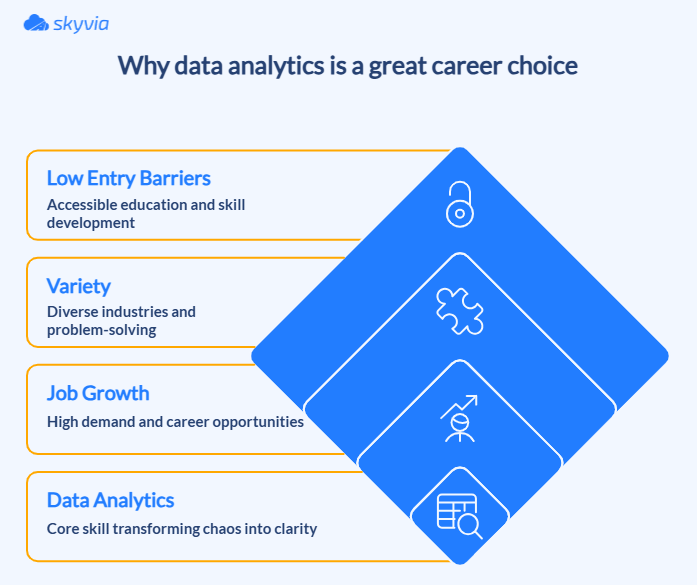
If there were no data analysts, the true value of data would be relatively flat and dull. Take analysts out of the equation, and any processes concerning growth and decisions would become a costly, low-effective guessing game.
That’s why a career in data analytics isn’t just promising, it’s practically a fast pass to the front of the innovation line.
- Data keeps multiplying by the hour, and the demand for skilled analysts rises just as fast
Demand for data pros is skyrocketing across industries and businesses of all sizes. A few decades ago, only large enterprises could afford data analytics – now, thanks to cloud infrastructure, machine learning, AI, and tools that make it accessible to beginners and business users alike, even a small flower shop has data worth analyzing – and the means to do it.
The US Bureau of Labor Statistics predicts analytics jobs will grow by over 21% by 2034, far ahead of most other careers. That’s a lot of open doors, and a chance to step in with skills that pay off in more ways than one.
- Versatility across industries
Marketing campaigns require your attention today. Supply chain problems surface tomorrow. The rotation keeps you sharp, but the absolute satisfaction comes from knowing your work alters course – business leaders adjust based on your findings. The spreadsheets suddenly carry more weight when those adjustments improve fairness or reduce harm.
- You don’t need decades of experience to start
Free courses in SQL, Python, Tableau, and Power BI are basically free trials for your brain. Try everything. Hate most of it. Fall weirdly in love with one tool at 3 AM when a query finally works.
All without tuition, deadlines, or anyone judging your learning pace. Either way, you’ll know before committing to bootcamps or degrees that cost more than a used car.
Top 5 Free Data Analytics Courses for Beginners
Data analytics sounds interesting, but committing hundreds of dollars to “interesting” feels reckless. And that’s fair. Free data analytics courses with certificates let you explore without the buyer’s remorse. Google offers the polished, professional route.
Udemy serves up scrappy tutorials that get straight to the point. However, some industry giants offer free treats as well. Let’s figure out what you really like before your credit card gets involved.
Google Data Analytics Professional Certificate (Coursera)
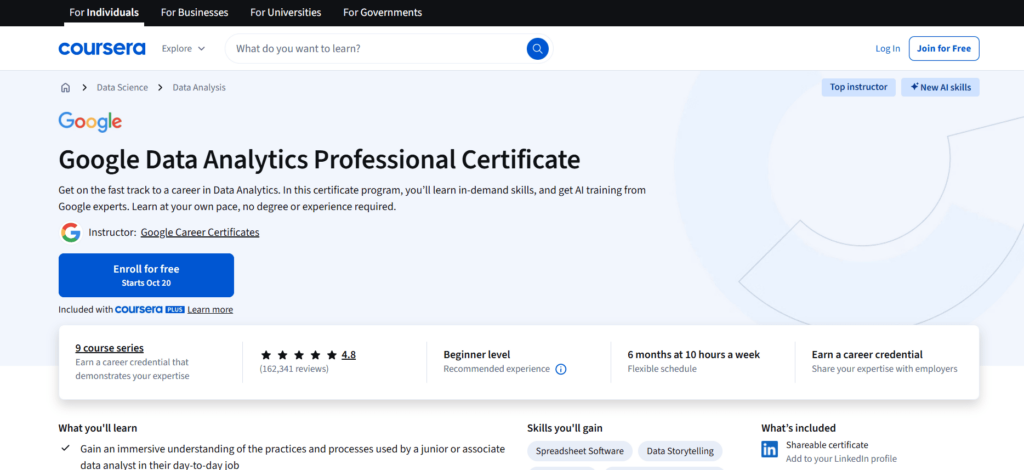
Duration: Six months, 10 hours each week, nine courses totaling somewhere around 180 to 240 hours before the certificate arrives.
Skills Acquired:
- The power to analyze data properly.
- Tableau skills for visualizations that don’t immediately bore people.
- SQL knowledge for database interrogation
- R programming ability.
- Spreadsheet proficiency that goes past SUM functions.
- Techniques for cleaning data that arrives broken.
- Ethical frameworks for when analytics enters gray areas.
- AI capabilities that improve your work.
Instructors: Not specified (Google team).
Important: The course itself is free if you have a Coursera subscription. After your 7-day trial period is over, you can continue learning for $35 a month.
Google built this data analytics course for people who want practical skills, not philosophical debates about data. Already over 13 million learners have enrolled in Google’s courses. Moreover, 75% of certificate graduates report a favorable employment outcome (such as a new job, promotion, or raise) within six months of graduation.
Start with spreadsheets. Graduate to SQL. Touch R without panicking. Learn Tableau so your visualizations stop looking like ransom notes.
Real cases, real exercises, and enough AI sprinkled in to keep things feeling current instead of dated. Plus, you’ll have portfolio pieces that don’t scream “I finished this 10 minutes ago.”
IBM Data Analyst Professional Certificate (Coursera)
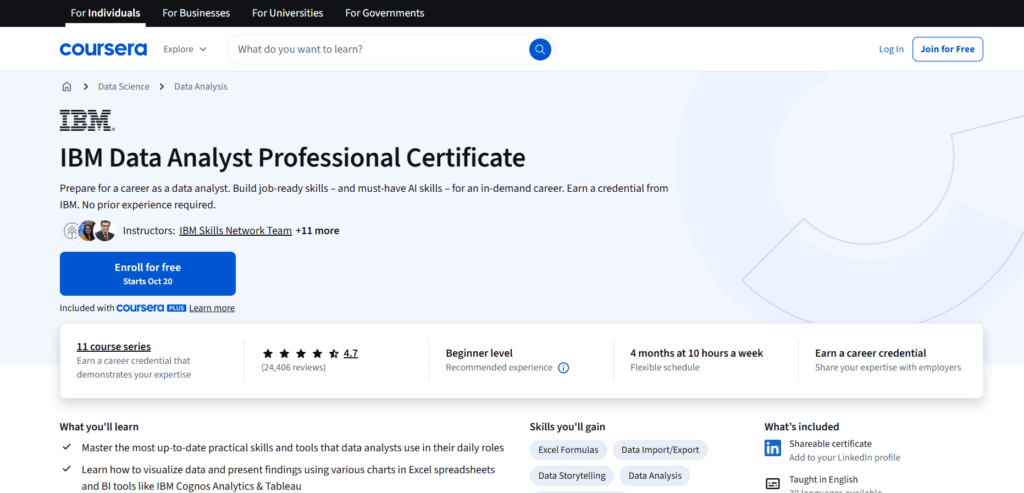
Duration: Four months at 10 hours per week – 11 courses totaling around 160 hours of your attention.
Skills Acquired:
- Excel skills that impress coworkers.
- Python fluency with Pandas and NumPy handling data gymnastics.
- SQL for database conversations.
- Scikit-learn to power your machine learning attempts.
- Cognos and Tableau to turn numbers into visuals.
- AI ethics for navigating algorithmic minefields.
- Regression modeling and dashboards that decision-makers actually open.
Instructors: IBM Skills Network Team, Joseph Santarcangelo (Ph.D., Data Scientist at IBM), Abhishek Gagneja (Financial Systems Analyst at American Express), and others.
Important: The course is free, but the Coursera subscription will cost $35 a month.
IBM’s data analyst professional course takes a different angle – Python and SQL dominate, with visualization and dashboards supporting from the sidelines. No fancy branding here, just straightforward skill-building that assumes you’ll learn by doing, not by watching someone else’s screen.
The capstone actually matters. Mentorship keeps you from spiraling when code breaks at midnight. It feels less like school, more like collaborating with people who’ve been there.
Along with a portfolio of your work and an IBM Professional Certificate to demonstrate your proficiency, you will also receive an IBM Digital badge and have access to career tools to aid in your job search.
Introduction to Data Analytics (Simplilearn)
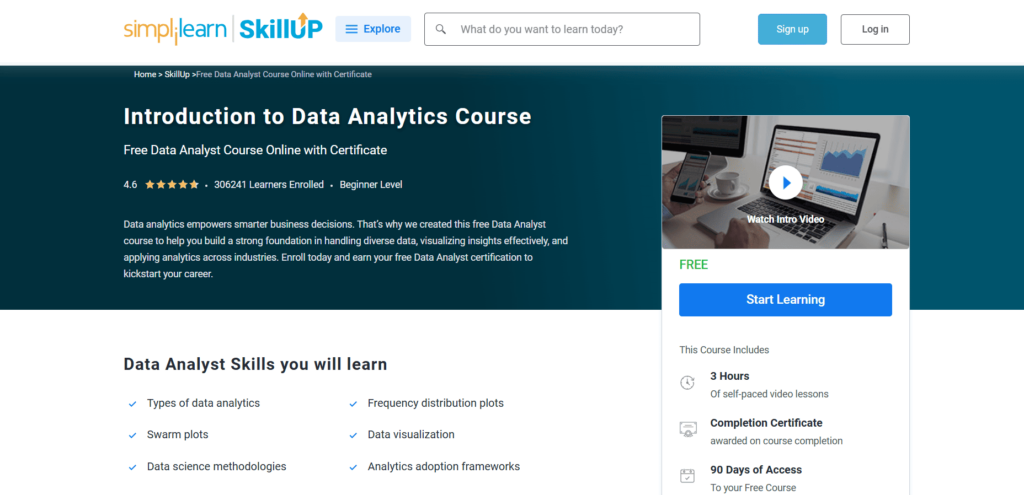
Duration: Three video hours accessible for 90 days before the clock runs out.
Skills Acquired:
- Analytics type distinctions.
- Frequency plots to make distributions visible.
- Swarm plots that preserve data individuality while showing clusters.
- Visualization tactics that land with audiences.
- Methodologies that structure your process.
- Frameworks that prevent analytical drift.
- Trends pointing to where analytics is headed next.
Instructors: Not specified (Simplilearn team).
Simplilearn built this introductory course to data analytics for the undecided: short course, flexible timing, fundamentals only – no deep dives that might scare you off. Tools appear. Visualizations happen.
You see analytics applied in different industries. Then you’re done, with enough context to know whether this field deserves more of your attention or not.
Introduction to Data Analysis for Beginners (Udemy)
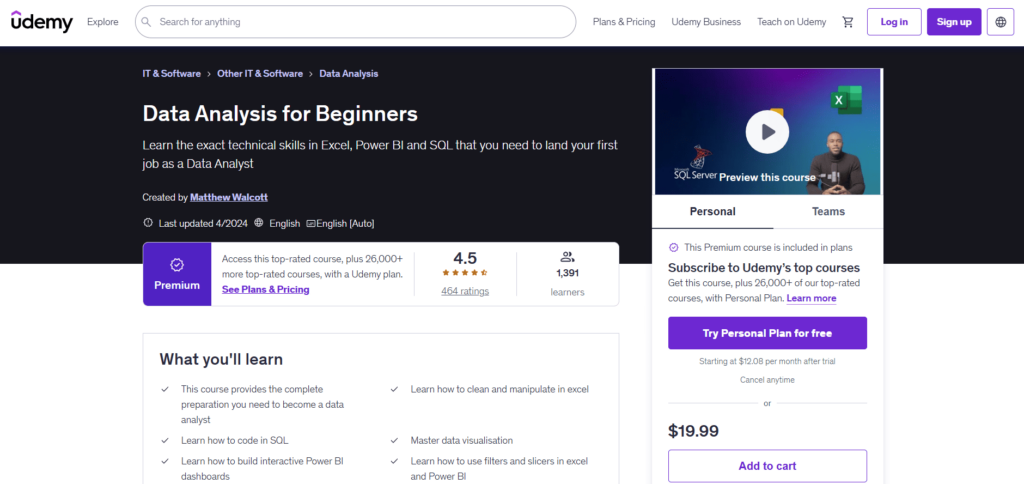
Duration: Four and a half hours from beginning to end.
Skills Acquired:
- Writing SQL queries that return useful results.
- Excel operations beyond copying formulas down.
- Dashboards showing metrics without clutter.
- Power Query that automates the data wrestling.
- Power BI visualizations that make numbers less intimidating.
Instructor: Matt Walcott (Senior Data Analyst and coach).
Udemy built this beginner course for data analysts-to-be like a trail guide written by someone who’s already gotten lost in these woods, but, in the end, found the way out. Short, helpful, grounded in mistakes they’ve already made for you.
Where do you find datasets that aren’t radioactive garbage? Which beginner projects teach you something instead of just frustrating you into quitting? What routes through the learning maze don’t waste months? It hands you the map before you wander off a cliff.
Excel Basics for Data Analysis (IBM on Coursera)
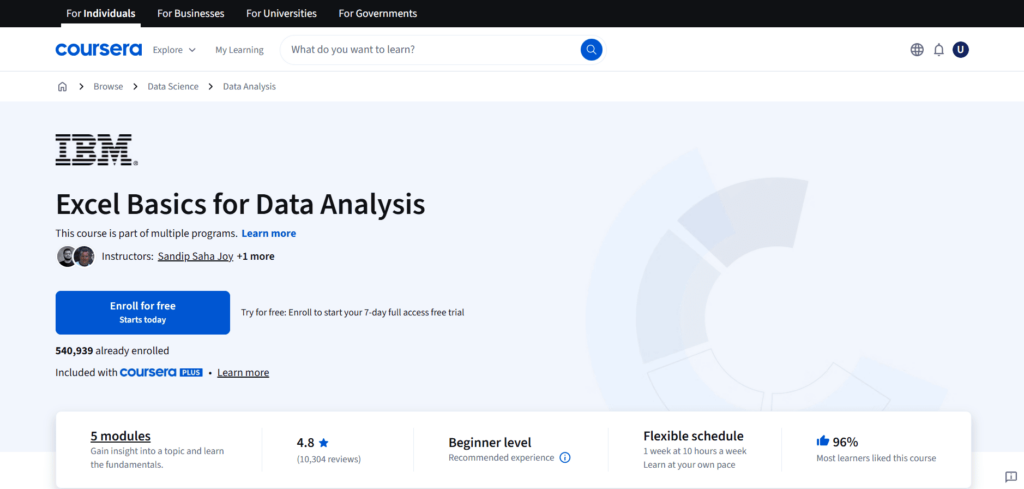
Duration: 10 hours, theoretically one week if life and schedule cooperate.
Skills Acquired:
- Moving through Excel confidently.
- Writing formulas that calculate.
- Cleaning data that arrived broken or incomplete.
- Pivot tables that do the summarizing work.
- Using filters to get exactly the subset you need.
- Lookups that pull information from other sheets.
Instructors: Sandip Saha Joy (former Data Scientist at IBM) and Steve Ryan (Learning Consultant at IBM).
Important: This Excel Basics course is a part of a bigger program devoted to Excel and Analytics, so you can choose what you want to learn specifically. Also, as with any Coursera content we discuss in the Free sections, you will need to pay $35 a month to have access to the platform.
Excel may not have the hype of SQL or Python, but it’s the unsung hero of analytics. IBM’s Excel course walks you from formulas and cleaning messy data to pivot tables and lookups. If you master Excel first, you’ll find SQL and visualization tools make a lot more sense – you’ve got a solid foundation to build on.
Best Free Courses to Master Specific Data Analytics Tools
After testing the analytics waters, you need to arm yourself. SQL, Python, and BI tools form the trinity of data work – your hammer, wrench, and measuring tape rolled into one toolkit.
Free courses exist that’ll turn you from a fumbling beginner into someone who knows which tool solves which problem. Here are the 2025 courses worth your time, each throwing you into real scenarios instead of hypothetical gibberish.
Free SQL Courses
Course 1: Databases and SQL for Data Science with Python (IBM on Coursera)
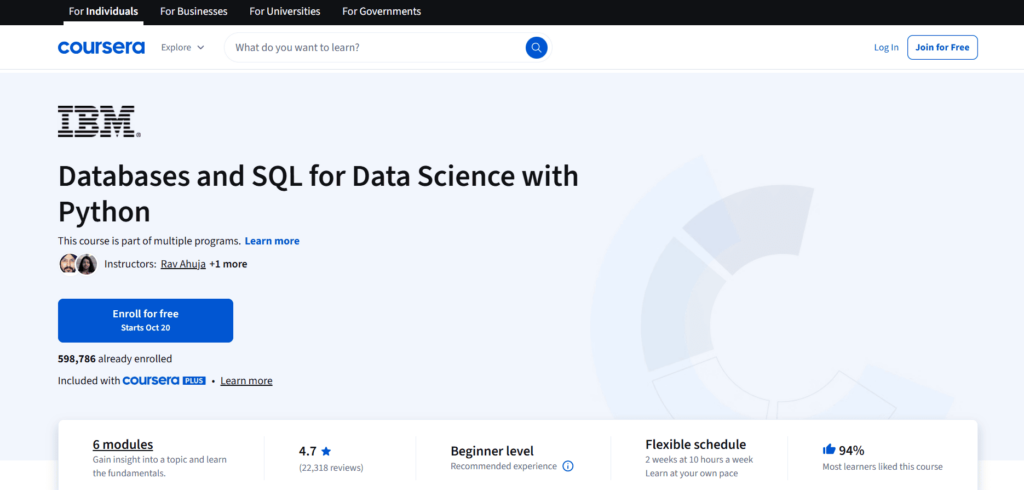
Duration: 20 hours spread across two weeks if you follow the suggested pace, but you can adjust as life demands.
Skills Acquired:
- Basic SQL commands that form your foundation.
- Building databases from scratch.
- Sharpening queries so they run efficiently.
- Integrating Python with databases using Jupyter notebooks and SQL magic commands.
- Tackling joins and views when simple queries won’t cut it.
- Working through real datasets instead of sanitized examples.
Instructors: Rav Ahuja (CCO & Global Program Director at IBM) and Hima Vasudevan (Data Scientist at IBM).
SQL scares people because it reads like code written by someone who hates vowels. This IBM course fixes that by pairing it with Python, which makes database queries click. You’ll work through tables, joins, transactions, all grounded in real data – Chicago city records that give context to your actions.
The focus stays on solving problems, not reciting syntax from memory. It’s your first proper database expedition, and Python’s there to translate when things get confusing.
Course 2: Learn SQL (Codecademy)
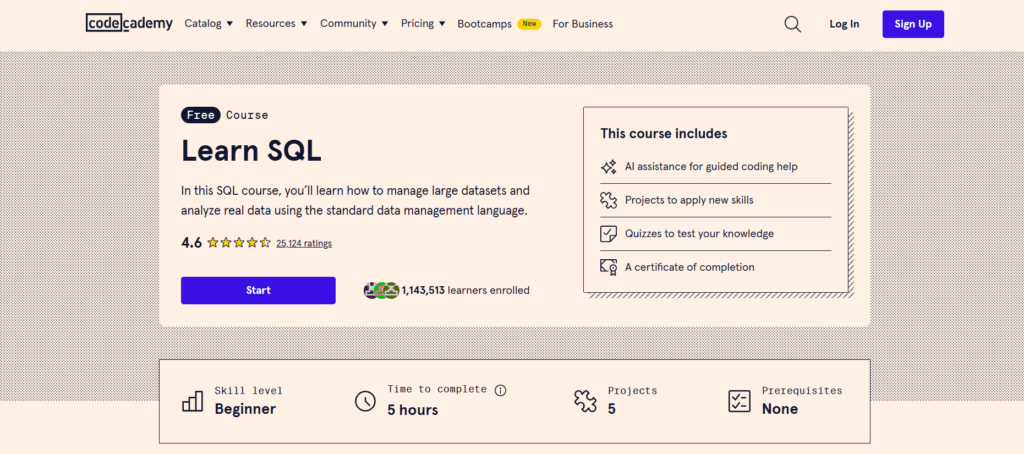
Duration: Five hours nominally, but pacing shifts based on your background.
Skills Acquired:
- Database operations through SQL.
- Query construction to pull exactly the data needed.
- Project work that applies analysis to problems worth solving.
Instructors: Codecademy team (not specified individually).
Codecademy’s SQL course moves fast. Ideal if you’d rather start writing queries today than read about them for a week. A few hours in, you’re past basic SELECT statements and working on real projects instead of toy examples.
Everything’s interactive, so you’re building from minute one. Best for people who learn by breaking things and fixing them, not by studying first.
Free Python for Data Analysis Courses
Course 1: Data Analysis with Python (freeCodeCamp)
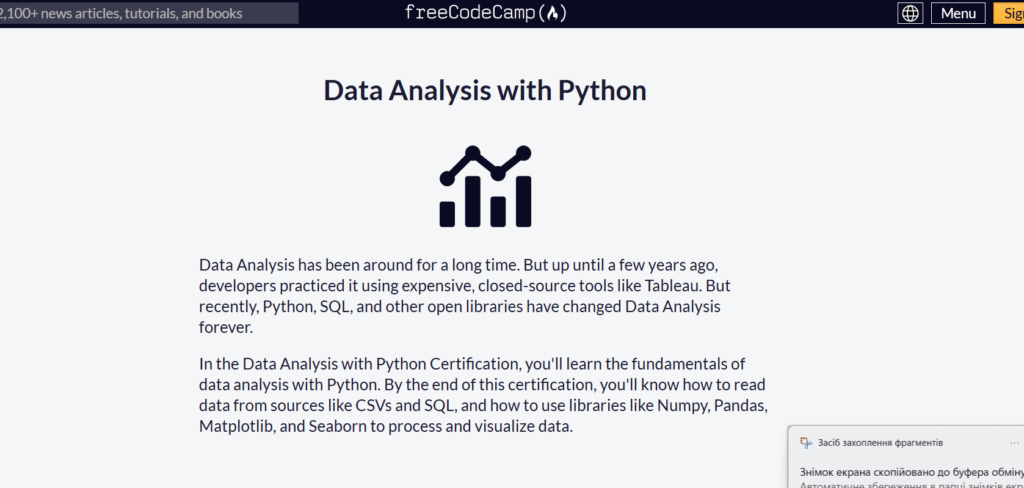
Duration: 300 hours, moving at your pace, projects forming a significant portion.
Skills Acquired:
- Getting data into Python from wherever it lives and scrubbing it clean.
- Working through analysis with NumPy.
- Doing math and Pandas handling dataframes.
- Creating visuals in Matplotlib and Seaborn that communicate clearly.
- Tackling project-based challenges that require thinking beyond just following instructions.
Instructors: freeCodeCamp team (community-driven).
The FreeCodeCamp Data Analysis with Python course doesn’t rush you. It is more of a cross-country trek than a city sprint. Pandas, NumPy, Matplotlib, and Seaborn are explored through datasets that misbehave like real data does.
Projects simulate actual analyst headaches, not the polished scenarios that exist only in slideshows, like learning to cook in a restaurant kitchen during dinner rush instead of following a recipe alone in your apartment.
Course 2: Python for Data Science, AI & Development (IBM on Coursera)
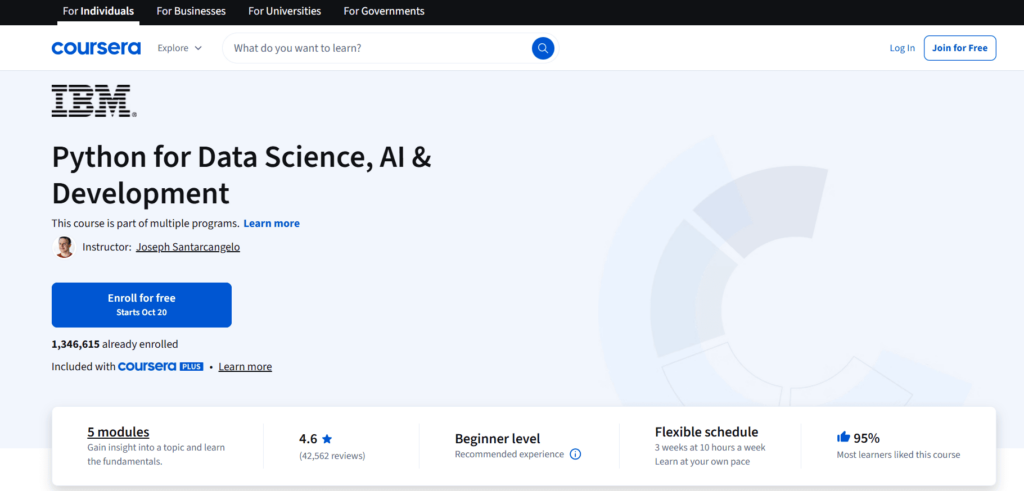
Duration: Three weeks, 10 hours a week – only 30 hours between you and Python competency.
Skills Acquired:
- Core Python.
- Data structures and logic that stop feeling abstract.
- Pandas and NumPy for reshaping information without losing your mind.
- Jupyter as your command center.
- API requests for pulling data from services.
- BeautifulSoup for scraping websites when they hide what you need behind HTML.
Instructors: Joseph Santarcangelo (Ph.D., Data Scientist at IBM).
IBM built its Python course assuming you will finish it. Labs keep landing, mini-projects stack up, APIs become another tool you reach for without thinking. You’re not stitching together random tutorials – someone mapped this out.
The focus stays practical: rip data from the web, knock off the rust, see what holds up under scrutiny. Web scraping and API skills push your range further than pre-packaged datasets ever will.
Free Business Intelligence (BI) Courses (Tableau & Power BI)
Course 1: Data Visualization With Power BI (Great Learning)
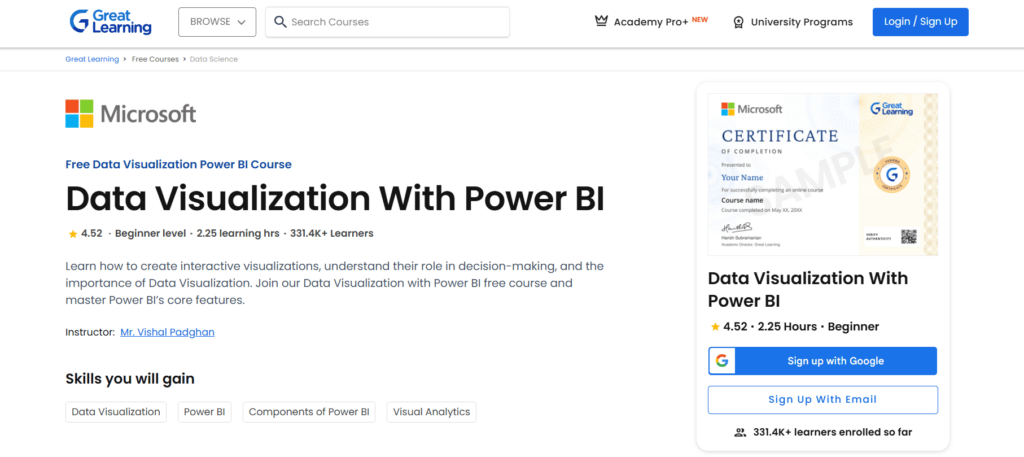
Duration: 2.25 hours – shorter than a nap.
Skills Acquired:
- Power BI from installation to first dashboard.
- DAX formulas that do the heavy math.
- Charts and graphs that communicate instead of decorating slides.
- Report creation that packages insights instead of burying them.
- Analysis methods that help you see patterns before your boss asks about them.
Instructors: Vishal Padghan (Data Science Expert).
If spreadsheets were your comfort zone, Power BI is your upgrade. This course by Great Learning gets you creating dashboards, reports, and charts fast. You’ll see how to move from raw data to visual stories that catch attention, without expensive software.
Course 2: Tableau Public Training (Tableau)
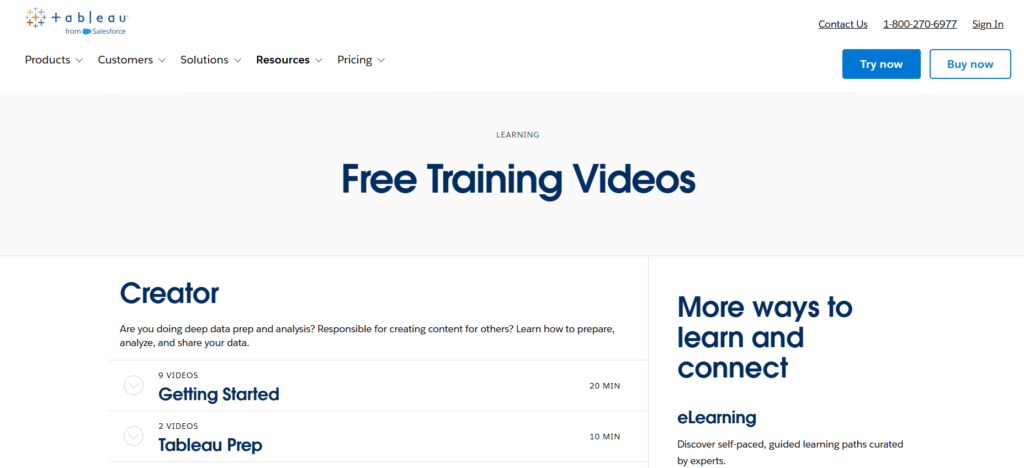
Duration: Modular structure means one to ten hours per topic – sprint through or take your time.
Skills Acquired:
- Data connections that don’t break every other day.
- Visualizations that communicate trends without essays explaining them.
- Dashboards that consolidate chaos into clarity.
- Calculation skills powerful enough for real analysis.
- Insight-sharing that reaches people who’d otherwise never see your work.
Instructors: Tableau experts (company-led).
Tableau’s free tutorials give visual minds something to chew on. You’re pushing elements around, testing combinations, finding out what makes a dashboard readable versus what just looks busy. Calculations feel less like math homework, and maps become storytelling tools.
The structure is loose enough to let you wander, focused enough to keep you moving forward. You’re building with genuine datasets, creating portfolio material that sits out in the open where it can do some good.
Top University-Led Free Data Analytics Courses
If you’re ready to walk the big league, university-led programs are a great next stop. These courses carry prestige and structure, giving you a taste of the rigor behind top data science degrees. While some expect some prior knowledge, they’re worth exploring for anyone curious about leveling up.
Harvard University: Data Science Courses (edX)
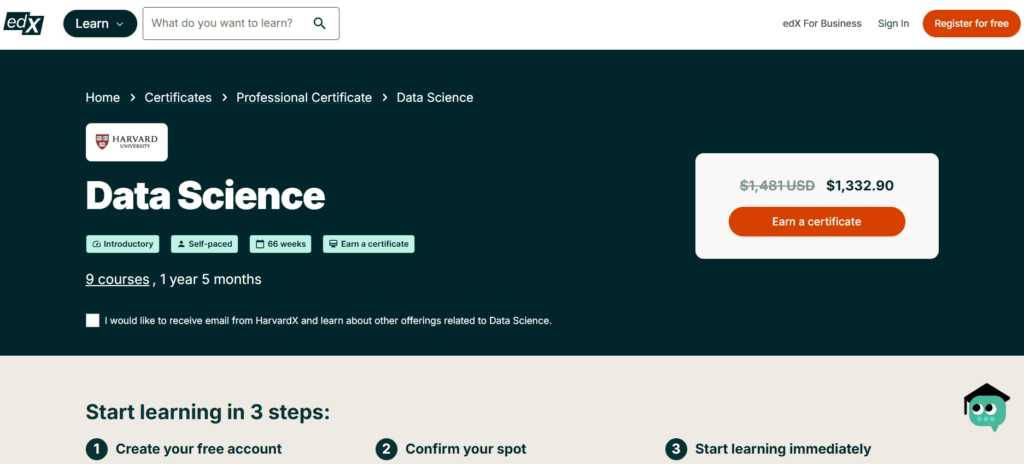
Duration: Approximately 1 year and 5 months (54 weeks total if sequential); most courses are 8 weeks (1-2 hours/week), with the capstone at 2 weeks. Self-paced.
Skills Acquired:
- R programming as your analytical lingua franca.
- Statistical thinking (probability, inference, modeling) that moves from abstract to concrete.
- Tidyverse tools like ggplot2 for graphics that communicate and dplyr for data surgery.
- Unix/Linux command line competency.
- Git and GitHub for version control that prevents disasters.
- Machine learning algorithms for problems that spreadsheets can’t solve.
Instructors: Rafael Irizarry (Professor of Biostatistics, Harvard T.H. Chan School of Public Health).
Fair warning: total beginners might feel like they’ve been tossed overboard without floaties. But push through and you’ll walk away with foundations that hold up, plus a capstone project worth putting your name on.
Harvard’s Data Science series on edX packs serious content. You’re working in R, cutting through probability, regression, and machine learning, but always tied to something concrete. Baseball stats get dissected Moneyball-style, election results get predicted, and suddenly the math has a pulse. It’s thorough, carries Harvard’s weight, and will absolutely test what you’re made of analytically.
University of Michigan: Python for Everybody (Coursera)
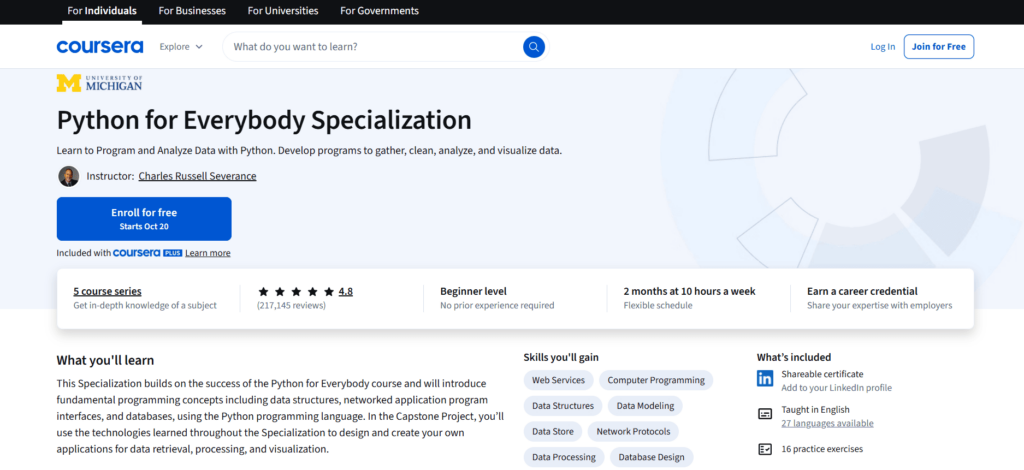
Duration: 2 months at 10 hours/week (~80-100 hours total); most complete in 8 months. Self-paced with monthly sessions.
Skills Acquired:
- Python programming fluency.
- Data structures that impose sanity on disorder.
- Web scraping for liberating data trapped in websites.
- RESTful APIs so you can request data properly.
- XML and JSON wrangling.
- SQL for talking to databases in their language.
- Database architecture understanding.
- Object-oriented programming that scales beyond quick scripts.
- Data cleansing workflows (raw data is always a disaster).
- Analysis methods that reveal what’s hiding.
- Visualization techniques that make findings legible.
- Algorithms designed for efficiency instead of just “make it work somehow.”
Instructors: Professor Charles Russell Severance (Clinical Professor at the University of Michigan School of Information).
Python for Everybody by the University is built for people switching lanes or just starting, who need to see results before patience runs out. Severance’s style feels like learning from someone who remembers what confusion feels like. You’ll come away surprised at what you managed to pull off.
Johns Hopkins University: R Programming (Coursera)
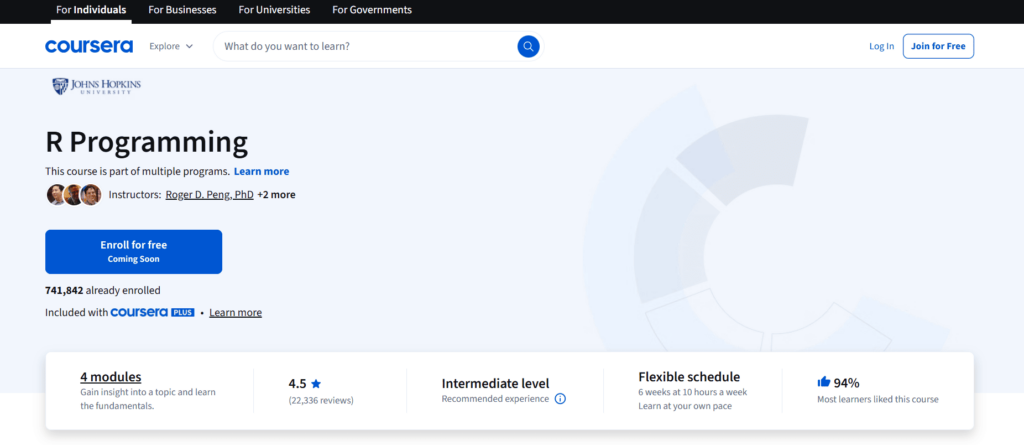
Duration: 4 weeks at 4-9 hours/week (~20-36 hours); self-paced.
Skills Acquired:
- R programming at an intermediate level.
- Data analysis that produces defensible results.
- Package ecosystems that save you from coding everything yourself.
- Custom functions to reduce repetitive work.
- Debugging strategies for when code breaks in mystifying ways.
- Profiling to identify where performance dies.
- Simulation to create synthetic data or test hypotheses.
- Parallelization that distributes workload across cores so tasks finish before you retire.
- Statistical computing principles that guarantee that your analysis stands on solid ground instead of assumptions.
Instructors: Roger D. Peng, Jeff Leek, Brian Caffo (Johns Hopkins).
Fair warning: Some assignments assume you’ve seen code before. Jumping in completely green might feel like learning to swim by getting thrown in the deep end.
R lovers, this one’s for you. Part of Johns Hopkins’ Data Science Specialization, the R Programming course gets your hands dirty. You’ll dive into simulations and parallel computing. Suitable for those who want to understand the nuts and bolts of statistical computation.
The Missing Piece: Why Data Integration is a Crucial Skill for Data Analysts
SQL, Python, R, Tableau – learn them all, but without one tiny detail, those skills won’t be used to their maximum because if there’s no data, then there’s no application for them.
Actual data sprawls across customer platforms, marketing tools, cloud drives, and connected hardware – none designed to play nice together. Integration handles that unglamorous part that everyone forgets about until they need it.
Integration powers the whole analytics operation, not just the beginning of it. For example, you’re dealing with Salesforce data that looks nothing like what Google Analytics spits out; SQL databases are structured their own way, and none fit together naturally. To catch patterns or make recommendations worth listening to, analysts need data from these sources to be appropriately merged.
However, this skill doesn’t require weeks or months of studying. It’s easier to manage than ever with no-code tools like Skyvia. Drop the API matches, forget scripting ETL processes, skip spinning ten different connectors. Analysts work through an interface, clicking through what they need while the platform does the work. Skyvia offers 200+ connectors, extracts what you need, transforms it into compatible formats, and loads it where you’re working.
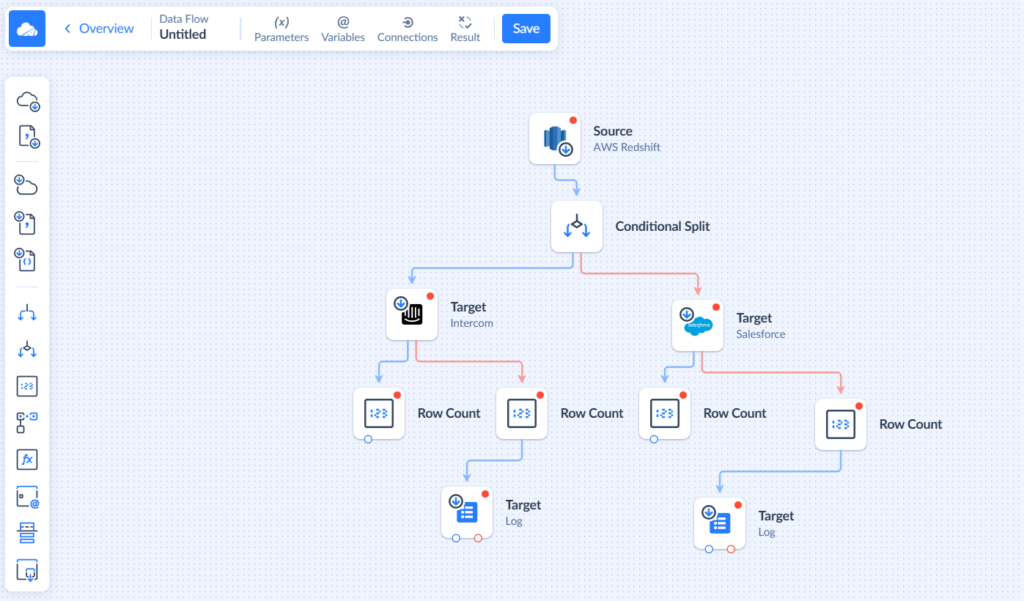
The best thing about Skyvia is that you can start building data pipelines like the one in the illustration a few seconds after you get your account. You spend your mental energy on analysis instead of keeping pipelines from falling apart.
The technical barriers dissolve. Whether you’re learning the ropes or coordinating data from everywhere, a free tier lets you operate without overhead.
Try connecting your first sources with Skyvia’s free plan. You’ll get a sense of how your courses translate into the actual workflow of a working analyst.
Comparison Table
| Course | Platform | Duration | Skill Focus | Free Certificate |
|---|---|---|---|---|
| Google Data Analytics Professional Certificate | Coursera | 180-240h | SQL, R, Tableau, AI | No (paid) |
| IBM Data Analyst Professional Certificate | Coursera | 160h | Python, SQL, Excel, AI | No (paid) |
| Intro to Data Analytics | Simplilearn | 3h | Visualization, Trends | Yes |
| Intro to Data Analytics for Absolute Beginners | Udemy | 0.5h | Mentorship, Basics | N/A (free courses) |
| IBM Excel Basics for Data Analysis | Coursera | 10h | Excel Analysis | No (paid) |
| IBM Databases and SQL for Data Science with Python | Coursera | ~20h | SQL, Python, Datasets | No (paid) |
| Learn SQL | Codecademy | 5h | SQL Queries & Projects | No (paid upgrade) |
| Data Analysis with Python | freeCodeCamp | 300h | Python, Pandas, NumPy, Visualization | Yes |
| IBM Python for Data Science | Coursera | ~30h | Python, Libraries, API, Web Scraping | No (paid) |
| Data Visualization With Power BI | Great Learning | 2.25h | Power BI, Visualizations, Reports | Yes |
| Tableau Public Training | Tableau | 1-10h per topic | Tableau Dashboards, Visual Analytics | No (badge possible) |
| Harvard University: Data Science Courses | edX | ~100-150h | R, Stats, ML, Tools | No (paid) |
| University of Michigan: Python for Everybody | Coursera | ~80-100h | Python, Data Handling, Web/DB | No (paid) |
| Johns Hopkins: R Programming | Coursera | ~20-36h | R Programming, Analysis | No (paid) |
How to Choose the Right Free Data Analytics Course for You
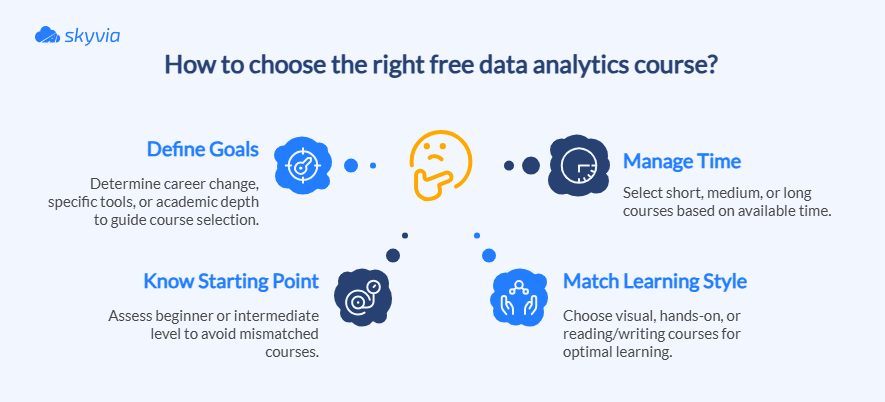
The right course reveals itself once you know what you’re chasing. Free data analytics training saturated every corner of the web in 2025, making selection an exhausting task.
Before committing, define your target clearly. Career change? Skill refresh? Trying to understand what your data team actually does? Jump in without direction, and you’ll finish feeling educated but no closer to whatever you hoped would change.
Assess Your Goals
Start with why you’re doing this. Leaving your field behind? Expanding what you bring to your current work? Just curious if data stuff resonates with you? The answer filters your options fast.
- Career-Focused: Choose courses addressing the hiring process itself. IBM’s Data Analyst offering blends AI integration with capstone projects, reflecting what Python/SQL positions require.
- Specific Skills: Chasing mastery of particular tools? Tableau Public Training or Great Learning’s Power BI fundamentals provide targeted instruction. Prefer academic depth? Michigan’s Python for Everybody covers data manipulation comprehensively.
- Tip: Study real job postings on LinkedIn to spot patterns in required competencies. Free data analytics courses with certificates (including audit pathways) boost credibility, particularly Coursera’s options that integrate with LinkedIn.
Measure Your Real Starting Point
Assess what you genuinely know. Total beginner with no coding or stats exposure? Some Excel ability and math comfort? Prerequisites differ significantly; specific courses assume a programming background, while others start from nothing and slowly lead you by the hand to a point where you can start something more advanced.
- Beginner-Friendly Options: Find courses marked “no prerequisites” or “introductory level.” Google’s Data Analytics certificate on Coursera starts blank, introducing data cleaning and visualization fundamentals. FreeCodeCamp’s Data Analysis with Python suits limited Python knowledge, paired with a hands-on learning preference.
- Intermediate/Advanced: Already have a foundation? Specialized options like Harvard’s Data Science on edX explore R programming, expecting basic math skills. Examine course descriptions for suggested preparation, level mismatch either under-stimulates or overwhelms.
Consider Your Learning Style
Information lands differently depending on the person – through visuals, audio, physical practice, or text. Choose course formats matching your processing style, and you’ll absorb faster with less frustration.
- Note: Courses typically combine methods – auditory, visual, kinesthetic/hands-on, etc.
- Tip: Try free samples to identify what resonates. Mixed formats benefit most learners, but respect your inclinations while grinding through passive content when you need hands-on work just burns time. Reddit conversations show visual and kinesthetic types lean toward Google’s combination of video instruction and practical labs.
Check the Time Commitment
Courses run anywhere from a couple of hours to several months. The range is huge. Understand what you’re signing up for to avoid the guilt spiral when you can’t keep up.
Thorough programs hover around six months, while condensed courses target specific capabilities without the extended timeline.
- Short commitments (under 10 hours): Calendar’s already packed? IBM’s Excel Basics won’t wreck your weekends – 10 hours total. Great Learning’s Power BI finishes in 2.25 hours. Targeted, efficient, done.
- Medium (10-50 hours): Maybe you’ve got evenings free. Codecademy’s SQL runs 5 hours. IBM’s Python for Data Science stretches to 30. Dedicate 5-10 hours per week, and these fit around jobs, kids, whatever else you’re juggling.
- Longer (50+ hours): Want the full treatment? Google’s certificate spans 180-240 hours over six months. Harvard’s exceeds 100 hours. Comprehensive but demanding. The self-paced angle helps – life happens, courses wait.
- Tip: Sketch out your week. Where’s that 10 hours coming from? Morning coffee sessions? Late nights? Be realistic. Coursera and edX specifically built flexibility into their platforms because most people can’t maintain rigid schedules. Testing interest? Go short first. No point committing months to something you might hate.
Conclusion
There’s your roadmap. Free courses teaching SQL, Python, R, Tableau, and Power BI – tools forming the foundation of analytics work. Google and IBM for certificates that carry weight, universities for academic credibility, and freeCodeCamp for learning without paywalls.
Some courses finish in hours, others span months. Some assume you’ve never seen code, others expect you to keep pace with university rigor. Match the course to your situation instead of picking whatever sounds impressive.
Then start. Tonight works. This weekend works. Whenever it works, just start somewhere. You’ll spend hours learning to query, analyze, visualize – all useful until you hit the problem courses don’t solve: data that won’t cooperate. Integration bridges that gap.
Skyvia’s free tier gives you the connectors and automation so that data actually shows up for analysis. Try it alongside your learning. Course skills plus integrated data equals what employers expect from working analysts, not just students finishing modules.
F.A.Q. for Best Free Data Analytics Courses
Are free data analytics courses really free?
Check pricing details on each platform before investing hours.” Free” often means “free without a certificate.” Coursera and edX offer free auditing but charge $35–$49 monthly for certificates. FreeCodeCamp provides everything free, including certificates.
What is the best free data analytics course for a complete beginner?
The Google Data Analytics Professional Certificate is beginner-friendly and industry-recognized. For completely free, including a certificate, freeCodeCamp’s Data Analysis with Python works well. Both start from zero, teach through doing, and don’t presume coding knowledge or a statistics background.
Do I need to be good at math to learn data analytics?
You will need basic numeracy skills, like understanding percentages, averages, and interpreting graphs. Advanced math isn’t required; tools handle heavy calculations. Logical thinking matters more.
What are the most important skills I will learn in these courses?
SQL for data extraction. Python or R for analysis tasks. Excel for routine work. Tableau/Power BI for visual communication. Data cleaning since real data arrives messy. Statistics fundamentals. Presenting your findings clearly to people who make decisions.
How long does it take to learn data analytics with a free course?
Short courses: several hours. Comprehensive certificates: 3-6 months at 10 hours weekly. Job-ready skills typically take 3-6 consistent months, including building projects beyond watching lectures. Previous coding experience shortens the timeline; complete beginners should expect the longer duration.



